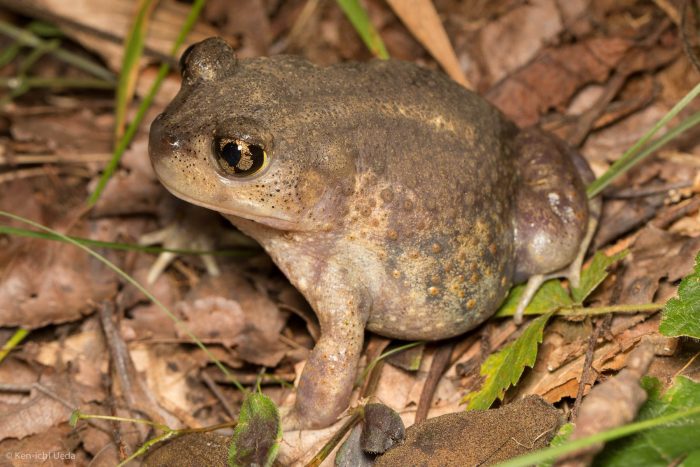Eastern Spadefoot
Scaphiopus holbrookii
Often mistaken for a toad, the Eastern spadefoot is a rare frog that breeds in flooded fields and vernal pools.
This section shows one large critter image at a time. Use the thumbnails that follow to select a specific image to display here.

This gallery contains a grid of small thumbnails. Selecting a thumbnail will change the main image in the preceding section.
Appearance
The eastern spadefoot is a typically brown to black soft-bodied frog with short legs. This species has distinct light bands running from the eye along the sides of their bodies. Their throat and chest is white, while the lower belly is a light gray to reddish color. They can also be distinguished from other frogs by their vertical, elliptical shaped pupils.
Feeding
As tadpoles, the eastern spadefoot consumes algae for its first few days of life, and then consumes drowned earthworms, dead plants or floating particles when their mouths fully develop. The diet of an adult includes a wide variety of invertebrates, especially ants, beetles, flies, grasshoppers, crickets, termites and worms.
Predators
Common predators of the eastern spadefoot are toads, bullfrogs, raccoons and various snake species. The dark coloring of the frog makes it easier for them to camouflage with the soil of their habitat, and they are also able to bury themselves into the soil in seconds to avoid predators.
Voice
The eastern spadefoot makes a loud, nasal aaaah sound lasting about one to five seconds.
Reproduction and life cycle
Breeding of the eastern spadefoot occurs after heavy rains, typically between March and June. The species breeds in temporarily flooded fields, ditches or other fishless, temporary pools. Eggs are deposited in vegetated areas of the water, and clutch size can range from 800 to 4,500 eggs, and can hatch anywhere between 12 hours to 14 days after fertilization depending on water and air temperature. Juveniles are immediately independent, as parents provide no care.
Did you know?
While the Eastern spadefoot had toad-like qualities and is often mistake for a toad, it is actually a primitive frog.
Eastern spadefoot tadpoles and frogs can have cannibalistic tendencies, often eating their own siblings.
During hibernation, the eastern spadefoot will curl into a tight ball and excrete a fluid that hardens the soil around them, forming a compact chamber to retain moisture.
Although the eastern spadefoot is both nocturnal and diurnal, they typically forage during the day, and have higher activity levels during more humid days.
The vertical shape of their pupils allows the eastern spadefoot to absorb as much light as possible during the night.
Sources and additional information
Eastern Spadefoot - Virginia Herpetological Society
Eastern Spadefoot - Connecticut Department of Energy & Environmental Protection
Eastern Spadefoot - Missouri Department of Conservation
Scaphiopus holbrooki - Animal Diversity Web
